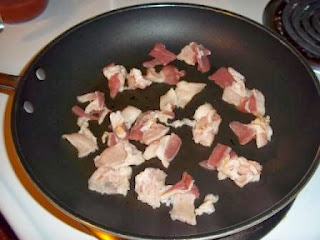Eating even a small handful of blueberries a day can help with healthy aging and prevention of memory loss. They also contain a compound that aids in lowering cholestrol. So blueberries basically rock.
Other fruits and veggies that fall into the blue/purple group are blackberries, blue corn, blue potatoes, eggplant, figs, plums, prunes, purple grapes, and raisins.
Blueberry Sauce
1 cup sugar
2 tbsp cornstarch
1/4 tsp nutmeg
dash of salt
1 cup boiling water
2 cups fresh blueberries
3 tbsp lemon juice
In a deep sauce pan combine sugar, corn starch, nutmeg, and salt.
Add in blueberries and bring to a boil again. Cook for 2 minute, stirring occasionally.
You can substitute frozen unsweetened blueberries, but they need to be thawed and drained. Increase cornstarch to 3 tbsp. Bring mixture to a boil, then remove from heat and add in blueberries and lemon juice at the same time (do not cook).
For the record, I am not being sponsored by the Ground Nutmeg Association, it's just coincidence that this makes two recipe in a row with nutmeg as the featured spice. If you aren't crazy about it, you can substitute 1/2 tsp of cinnamon in lieu of the 1/4 tsp of nutmeg.
What can you do with blueberry sauce? What can't you do is my question. You can serve it over poundcake, pancakes or waffles. You can serve it over ice cream, frozen yogurt or pudding. You can add it to a smoothie or milkshake. You can serve it with oatmeal or use it to layer a trifle or yogurt parfait like I did.
Blueberry Yogurt Parfait
Vanilla yogurt
Granola
Sliced almonds
Blueberry sauce
Altermate layers of yogurt, granola, nuts and sauce in a tall thin serving dish (like a clear coffee cup or drinking glass). Garnish with fresh berries and almonds. Pretty and pretty good!















































